
- •Activity 1.1.1: Using Google Earth™ to View the World
- •Activity 1.4.5: Identifying Top Security Vulnerabilities
- •Lab 1.6.1: Using Collaboration Tools— IRC and IM
- •Lab 1.6.2: Using Collaboration Tools—Wikis and Web Logs
- •1.7.1: Skills Integration Challenge-Introduction to Packet Tracer
- •Activity 2.2.5: Using NeoTrace™ to View Internetworks
- •Lab 2.6.1: Topology Orientation and Building a Small Network
- •Lab 2.6.2: Using Wireshark™ to View Protocol Data Units
- •2.7.1: Skills Integration Challenge-Examining Packets
- •Activity 3.4.1: Data Stream Capture
- •Lab 3.4.2: Managing a Web Server
- •Lab 3.4.3: E-mail Services and Protocols
- •Lab 4.5.1: Observing TCP and UDP using Netstat
- •Lab 4.5.2: TCP/IP Transport Layer Protocols, TCP and UDP
- •Lab 4.5.3: Application and Transport Layer Protocols Examination
- •Lab 5.5.1: Examining a Device’s Gateway
- •Lab 5.5.2: Examining a Route
- •5.6.1: Skills Integration Challenge-Routing IP Packets
- •Lab 6.7.1: Ping and Traceroute
- •Lab 6.7.2: Examining ICMP Packets
- •Activity 6.7.3: IPv4 Address Subnetting Part 1
- •Activity 6.7.4: IPv4 Address Subnetting Part 2
- •Lab 6.7.5: Subnet and Router Configuration
- •Lab 7.5.2: Frame Examination
- •7.6.1: Skills Integration Challenge-Data Link Layer Issues
- •Lab 8.4.1: Media Connectors Lab Activity
- •Lab 9.8.1: Address Resolution Protocol (ARP)
- •Lab 9.8.2: Cisco Switch MAC Table Examination
- •Lab 9.8.3: Intermediary Device as an End Device
- •9.9.1: Skills Integration Challenge-Switched Ethernet
- •Lab 10.3.2: How Many Networks?
- •Lab 10.6.1: Creating a Small Lab Topology
- •Lab 10.6.2: Establishing a Console Session with HyperTerminal
- •Lab 10.6.3: Establishing a Console Session with Minicom
- •11.4.3.3: Network Latency Documentation with Ping
- •Lab 11.5.1: Basic Cisco Device Configuration
- •Lab 11.5.2: Managing Device Configuration
- •Lab 11.5.3: Configure Host Computers for IP Networking
- •Lab 11.5.4: Network Testing
- •Lab 11.5.5: Network Documentation with Utility Commands
- •Lab 11.5.6: Final Case Study - Datagram Analysis with Wireshark

Activity 6.7.4: IPv4 Address Subnetting Part 2
Learning Objectives
Upon completion of this activity, you will be able to determine subnet information for a given IP address and subnetwork mask.
Background
Borrowing Bits
How many bits must be borrowed to create a certain number of subnets or a certain number of hosts per subnet?
Using this chart, it is easy to determine the number of bits that must be borrowed.
Things to remember:
•Subtract 2 for the usable number of hosts per subnet, one for the subnet address and one for the broadcast address of the subnet.
210 |
29 |
28 |
27 |
26 |
25 |
24 |
23 |
22 |
21 |
20 |
1,024 |
512 |
256 |
128 |
64 |
32 |
16 |
8 |
4 |
2 |
1 |
|
|
|
|
|
|
|
|
|
|
|
Number of bits borrowed: |
|
|
|
|
|
|
|
|||
10 |
|
|
|
6 |
|
|
|
|
|
|
9 |
8 |
7 |
5 |
4 |
3 |
2 |
1 |
1 |
||
|
|
|
|
|
|
|
|
|
|
|
1,024 |
512 |
256 |
128 |
64 |
32 |
16 |
8 |
4 |
2 |
1 |
|
|
|
|
|
|
|
|
|
|
|
|
|
Hosts or Subnets |
|
|
|
|
|
|||
|
|
|
|
|
|
|
|
|
|
|
Possible Subnet Mask Values
Because subnet masks must be contiguous 1’s followed by contiguous 0’s, the converted dotted decimal notation can contain one of a certain number of values:
Dec. Binary
255 11111111
254 11111110
252 11111100
248 11111000
240 11110000
224 11100000
192 11000000
128 10000000
000000000
All contents are Copyright © 1992–2007 Cisco Systems, Inc. All rights reserved. This document is Cisco Public Information. |
Page 1 of 8 |
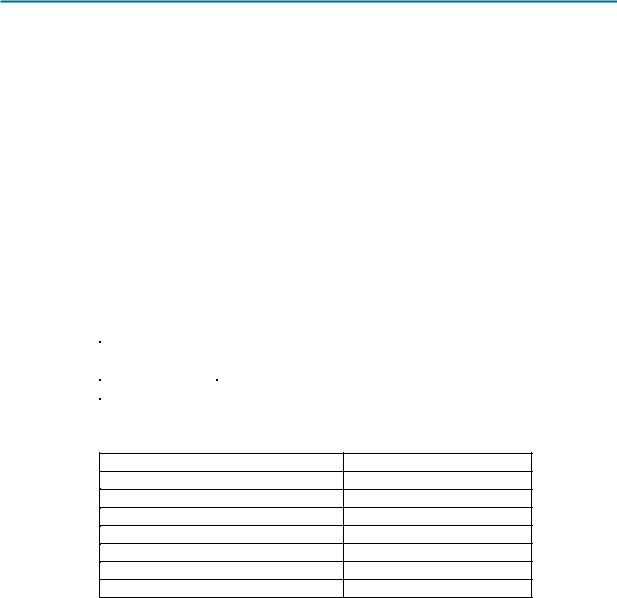
CCNA Exploration |
|
Network Fundamentals: |
|
Addressing the Network - IPv4 |
Activity 6.7.4: IPv4 Address Subnetting Part 2 |
Scenario
When given an IP address, network mask, and subnetwork mask, you will be able to determine other information about the IP address such as:
•The subnet address of this subnet
•The broadcast address of this subnet
•The range of host addresses for this subnet
•The maximum number of subnets for this subnet mask
•The number of hosts for each subnet
•The number of subnet bits
•The number of this subnet
Task 1: For a Given IP Address and Subnet Mask, Determine Subnet Information.
Given:
Host IP Address |
172.25.114.250 |
|
|
Network Mask |
255.255.0.0 (/16) |
|
|
Subnet Mask |
255.255.255.192 (/26) |
Find:
Number of Subnet Bits
Number of Subnets
Number of Host Bits per Subnet
Number of Usable Hosts per Subnet
Subnet Address for this IP Address
IP Address of First Host on this Subnet
IP Address of Last Host on this Subnet
Broadcast Address for this Subnet
Step 1: Translate host IP address and subnet mask into binary notation.
|
172 |
25 |
114 |
250 |
IP Address |
10101100 |
11001000 |
01110010 |
11111010 |
|
11111111 |
11111111 |
11111111 |
11000000 |
Subnet Mask |
255 |
255 |
255 |
192 |
Step 2: Determine the network (or subnet) where this host address belongs.
1.Draw a line under the mask.
2.Perform a bit-wise AND operation on the IP Address and the Subnet Mask.
Note: 1 AND 1 results in a 1’ 0 AND anything results in a 0.
3.Express the result in dotted decimal notation.
All contents are Copyright © 1992–2007 Cisco Systems, Inc. All rights reserved. This document is Cisco Public Information. |
Page 2 of 8 |
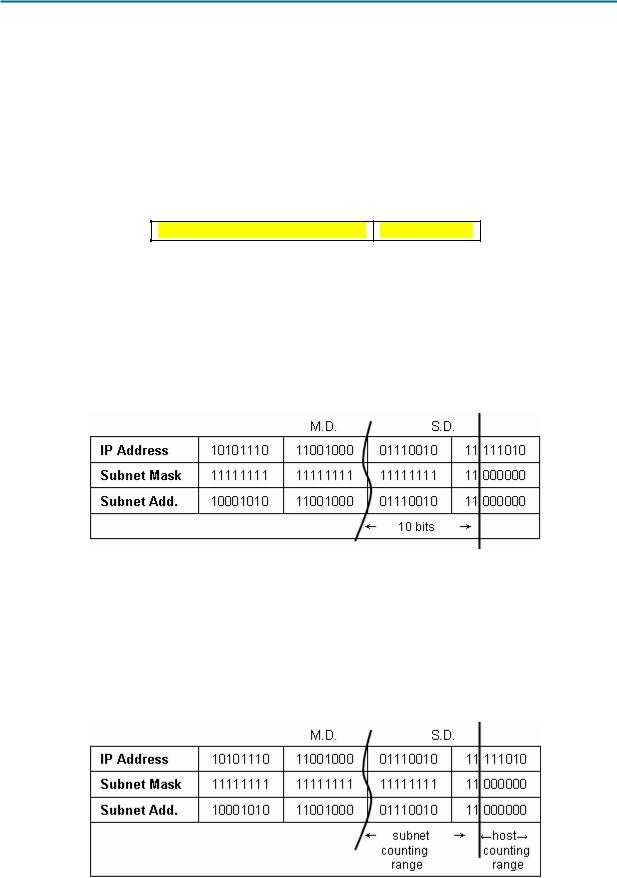
CCNA Exploration |
|
Network Fundamentals: |
|
Addressing the Network - IPv4 |
Activity 6.7.4: IPv4 Address Subnetting Part 2 |
4. The result is the Subnet Address of this Subnet, which is 172.25.114.192
|
172 |
25 |
114 |
250 |
IP Address |
10101100 |
11001000 |
01110010 |
11111010 |
Subnet Mask |
11111111 |
11111111 |
11111111 |
11000000 |
Subnet Address |
10101100 |
11001000 |
01110010 |
11000000 |
|
172 |
25 |
114 |
192 |
Add this information to the table:
Subnet Address for this IP Address 172.25.114.192
Step 3: Determine which bits in the address contain network information and which contain host information.
1.Draw the Major Divide (M.D.) as a wavy line where the 1s in the major network mask end (also the mask if there was no subnetting). In our example, the major network mask is 255.255.0.0, or the first 16 left-most bits.
2.Draw the Subnet Divide (S.D.) as a straight line where the 1s in the given subnet mask end. The network information ends where the 1s in the mask end.
3.The result is the Number of Subnet Bits, which can be determined by simply counting the number of bits between the M.D. and S.D., which in this case is 10 bits.
Step 4: Determine the bit ranges for subnets and hosts.
1.Label the subnet counting range between the M.D. and the S.D. This range contains the bits that are being incremented to create the subnet numbers or addresses.
2.Label the host counting range between the S.D. and the last bits at the end on the right. This range contains the bits that are being incremented to create the host numbers or addresses.
All contents are Copyright © 1992–2007 Cisco Systems, Inc. All rights reserved. This document is Cisco Public Information. |
Page 3 of 8 |
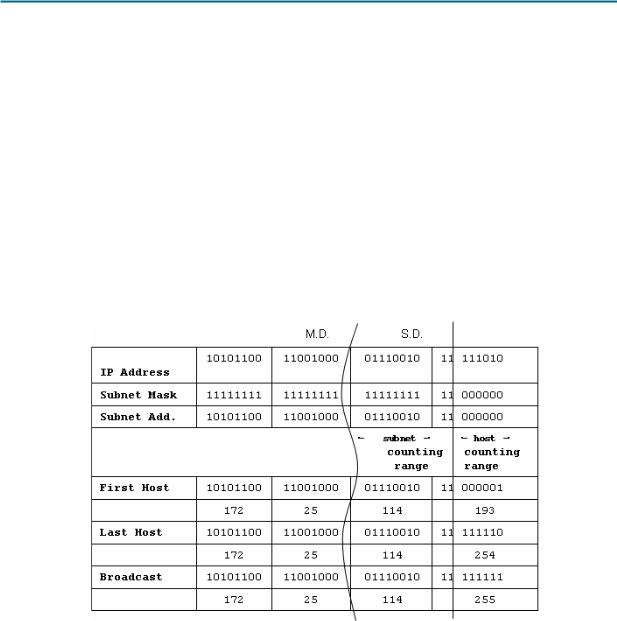
CCNA Exploration |
|
Network Fundamentals: |
|
Addressing the Network - IPv4 |
Activity 6.7.4: IPv4 Address Subnetting Part 2 |
Step 5: Determine the range of host addresses available on this subnet and the broadcast address on this subnet.
1.Copy down all of the network/subnet bits of the network address (that is, all bits before the S.D.).
2.In the host portion (to the right of the S.D.), make the host bits all 0s except for the right-most bit (or least significant bit), which you make a 1. This gives us the first host IP address on this subnet, which is the first part of the result for Range of Host Addresses for This Subnet, which in the example is 172.25.114.193.
3.Next, in the host portion (to the right of the S.D.), make the host bits all 1s except for the rightmost bit (or least significant bit), which you make a 0. This gives us the last host IP address on this subnet, which is the last part of the result for Range of Host Addresses for This Subnet, which in the example is 172.25.114.254.
4.In the host portion (to the right of the S.D.), make the host bits all 1s. This gives us the broadcast IP address on this subnet. This is the result for Broadcast Address of This Subnet, which in the example is 172.25.114.255.
All contents are Copyright © 1992–2007 Cisco Systems, Inc. All rights reserved. This document is Cisco Public Information. |
Page 4 of 8 |
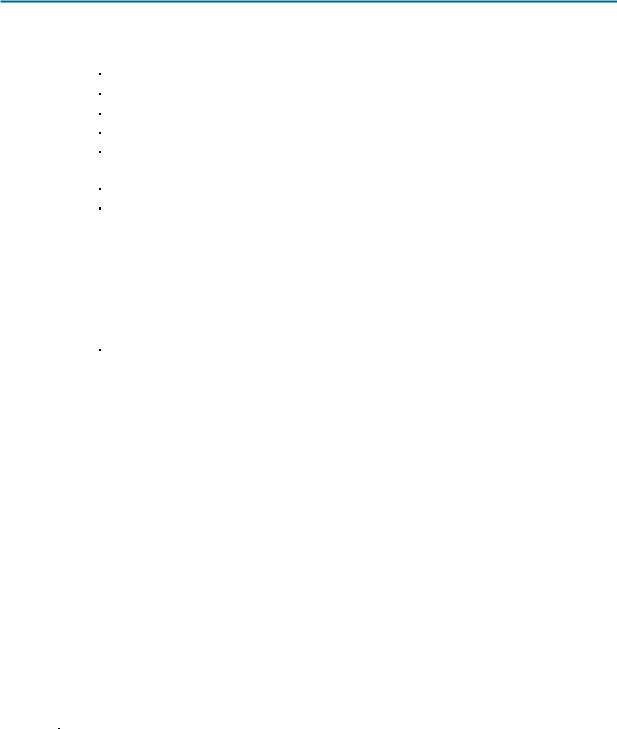
CCNA Exploration |
|
Network Fundamentals: |
|
Addressing the Network - IPv4 |
Activity 6.7.4: IPv4 Address Subnetting Part 2 |
Let’s add some of this information to our table:
Host IP Address |
172.25.114.250 |
|
|
Major Network Mask |
255.255.0.0 (/16) |
Major (Base) Network Address |
172.25.0.0 |
|
|
Major Network Broadcast Address |
172.25.255.255 |
|
|
Total Number of Host Bits |
16 bits or 216 or 65,536 total hosts |
Number of Hosts |
65,536 – 2 = 65,534 usable hosts |
|
|
Subnet Mask |
255.255.255.192 (/26) |
Number of Subnet Bits |
|
Number of Subnets |
|
|
|
Number of Host Bits per Subnet |
|
Number of Usable Hosts per Subnet |
|
|
|
Subnet Address for this IP Address |
|
|
|
IP Address of First Host on this Subnet |
|
|
|
IP Address of Last Host on this Subnet |
|
|
|
Broadcast Address for this Subnet |
|
|
|
Step 6: Determine the number of subnets.
The number of subnets is determined by how many bits are in the subnet counting range (in this example, 10 bits).
Use the formula 2n, where n is the number of bits in the subnet counting range.
1. 210 = 1024
Number of Subnet Bits |
10 bits |
Number of Subnets |
210 = 1024 subnets |
(all 0s used, all 1s not used) |
|
|
|
Step 7: Determine the number usable hosts per subnet.
The number of hosts per subnet is determined by the number of host bits (in this example, 6 bits) minus 2 (1 for the subnet address and 1 for the broadcast address of the subnet).
26 – 2 = 64 – 2 = 62 hosts per subnet
Number of Host Bits per Subnet |
6 bits |
Number of Usable Hosts per Subnet |
26 – 2 = 64 – 2 = 62 hosts per subnet |
All contents are Copyright © 1992–2007 Cisco Systems, Inc. All rights reserved. This document is Cisco Public Information. |
Page 5 of 8 |

CCNA Exploration |
|
Network Fundamentals: |
|
Addressing the Network - IPv4 |
Activity 6.7.4: IPv4 Address Subnetting Part 2 |
Step 8: Final Answers
Host IP Address |
172.25.114.250 |
|
|
Subnet Mask |
255.255.255.192 (/26) |
|
|
Number of Subnet Bits |
26 bits |
Number of Subnets |
210 = 1024 subnets |
|
|
Number of Host Bits per Subnet |
6 bits |
Number of Usable Hosts per Subnet |
26 – 2 = 64 – 2 = 62 hosts per subnet |
Subnet Address for this IP Address |
172.25.114.192 |
|
|
IP Address of First Host on this Subnet |
172.25.114.193 |
|
|
IP Address of Last Host on this Subnet |
172.25.114.254 |
|
|
Broadcast Address for this Subnet |
172.25.114.255 |
Task 2: Challenge.
For all problems:
Create a Subnetting Worksheet to show and record all work for each problem.
Problem 1
Host IP Address |
172.30.1.33 |
|
|
Subnet Mask |
255.255.255.0 |
|
|
Number of Subnet Bits |
|
|
|
Number of Subnets |
|
|
|
Number of Host Bits per Subnet |
|
|
|
Number of Usable Hosts per Subnet |
|
|
|
Subnet Address for this IP Address |
|
|
|
IP Address of First Host on this Subnet |
|
|
|
IP Address of Last Host on this Subnet |
|
|
|
Broadcast Address for this Subnet |
|
|
|
Problem 2
Host IP Address |
172.30.1.33 |
|
|
Subnet Mask |
255.255.255.252 |
|
|
Number of Subnet Bits |
|
|
|
Number of Subnets |
|
|
|
Number of Host Bits per Subnet |
|
|
|
Number of Usable Hosts per Subnet |
|
|
|
Subnet Address for this IP Address |
|
|
|
IP Address of First Host on this Subnet |
|
|
|
IP Address of Last Host on this Subnet |
|
|
|
Broadcast Address for this Subnet |
|
All contents are Copyright © 1992–2007 Cisco Systems, Inc. All rights reserved. This document is Cisco Public Information. |
Page 6 of 8 |
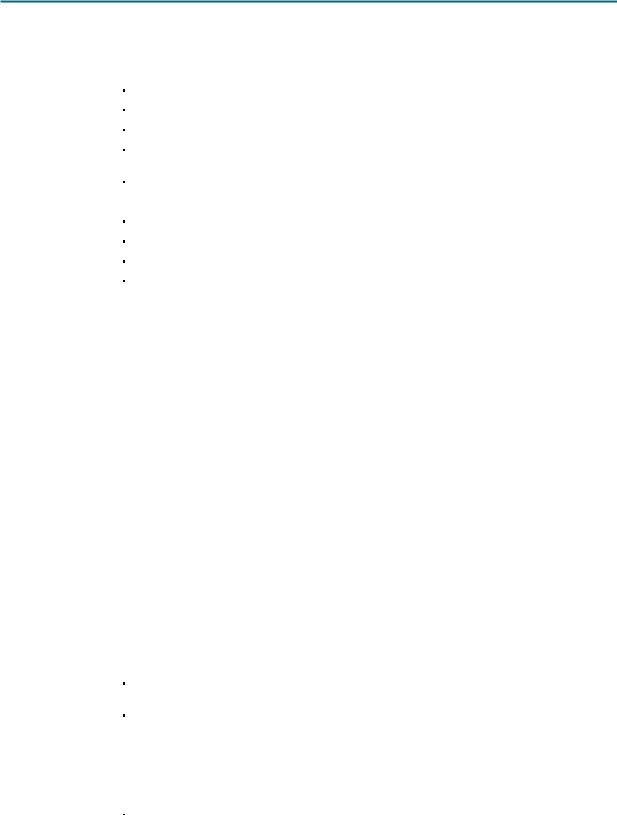
CCNA Exploration |
|
Network Fundamentals: |
|
Addressing the Network - IPv4 |
Activity 6.7.4: IPv4 Address Subnetting Part 2 |
Problem 3
Host IP Address |
192.192.10.234 |
|
|
Subnet Mask |
255.255.255.0 |
|
|
Number of Subnet Bits |
|
|
|
Number of Subnets |
|
|
|
Number of Host Bits per Subnet |
|
|
|
Number of Usable Hosts per Subnet |
|
|
|
Subnet Address for this IP Address |
|
|
|
IP Address of First Host on this Subnet |
|
IP Address of Last Host on this Subnet |
|
|
|
Broadcast Address for this Subnet |
|
|
|
Problem 4
Host IP Address |
172.17.99.71 |
|
|
Subnet Mask |
255.255.0.0 |
|
|
Number of Subnet Bits |
|
|
|
Number of Subnets |
|
|
|
Number of Host Bits per Subnet |
|
|
|
Number of Usable Hosts per Subnet |
|
|
|
Subnet Address for this IP Address |
|
|
|
IP Address of First Host on this Subnet |
|
|
|
IP Address of Last Host on this Subnet |
|
|
|
Broadcast Address for this Subnet |
|
|
|
Problem 5
Host IP Address |
192.168.3.219 |
|
|
Subnet Mask |
255.255.255.0 |
|
|
Number of Subnet Bits |
|
|
|
Number of Subnets |
|
|
|
Number of Host Bits per Subnet |
|
|
|
Number of Usable Hosts per Subnet |
|
|
|
Subnet Address for this IP Address |
|
|
|
IP Address of First Host on this Subnet |
|
|
|
IP Address of Last Host on this Subnet |
|
|
|
Broadcast Address for this Subnet |
|
|
|
All contents are Copyright © 1992–2007 Cisco Systems, Inc. All rights reserved. This document is Cisco Public Information. |
Page 7 of 8 |
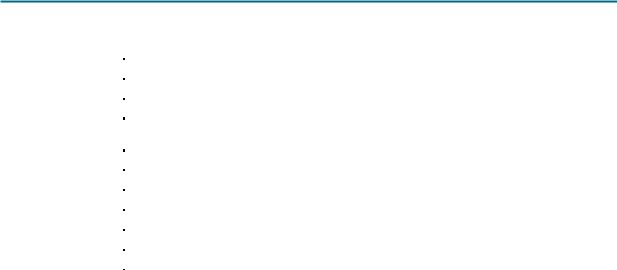
CCNA Exploration |
|
Network Fundamentals: |
|
Addressing the Network - IPv4 |
Activity 6.7.4: IPv4 Address Subnetting Part 2 |
Problem 6
Host IP Address |
192.168.3.219 |
|
|
Subnet Mask |
255.255.255.252 |
|
|
Number of Subnet Bits |
|
|
|
Number of Subnets |
|
|
|
Number of Host Bits per Subnet |
|
|
|
Number of Usable Hosts per Subnet |
|
|
|
Subnet Address for this IP Address |
|
|
|
IP Address of First Host on this Subnet |
|
IP Address of Last Host on this Subnet |
|
|
|
Broadcast Address for this Subnet |
|
Task 3: Clean Up
Remove anything that was brought into the lab, and leave the room ready for the next class.
All contents are Copyright © 1992–2007 Cisco Systems, Inc. All rights reserved. This document is Cisco Public Information. |
Page 8 of 8 |
